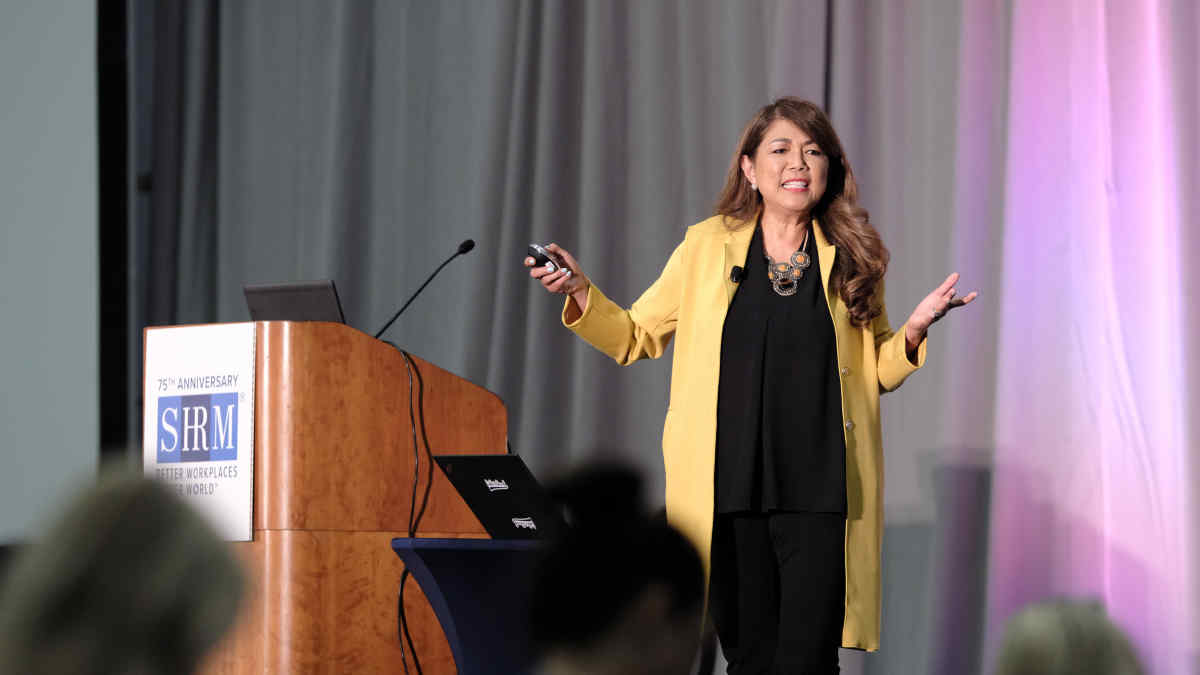
How long do you want to live? That’s the question Sonia Aranza, CEO and principal consultant at Aranza Communications, posed during a session on ageism at the SHRM INCLUSION 2023 conference on Nov. 1 in Savannah, Ga.
“Deep inside, we want to live a long life,” and that involves aging, she observed.
But there is a pronounced bias around age, Aranza said during the session “Unleash the Power of a Multigenerational Workforce and Confront Ageism.” Contributing to the prevalence of ageism is that for the first time in U.S. history, five generations are working side by side, as 25 percent of Baby Boomers and 2 percent of Traditionalists are part of the workforce.
Meet the Five Generations
“The key to working effectively across generations is to understand the compelling messages each generation grew up with and how it shaped their view of the world,” Aranza said.
\She profiled each generation’s personality based on information she gleaned from SHRM, the Pew Research Center, EY and Harvard Business Review:
Generation Z
Born 1997-2012, the oldest members are 26.
While this generation makes up only 5 percent of the current U.S. workforce, there are 2 billion Generation Z members worldwide. This generation favors job satisfaction over security, likes mobility and exploration, has a global mindset, and is bold, fearless and innovative, Aranza said.
Generation Y/Millennials
Born 1981-1996, they are ages 27 to 42 and make up 35 percent of the U.S. workforce.
As children, Millennials were the center of their parents’ universe, and the messages from that child-focused rearing were: “You are special.” “Achieve now.” “You can do it.” “Express yourself.” When participating on teams, they were told they were all winners—”a big fat lie,” Aranza said.
And their parents routinely solicited their opinions for something as simple as whether they wanted pasta or chicken for dinner. By contrast, Aranza—a Baby Boomer—recalled to loud laughter being expected to eat whatever her mother put on the table or else go hungry.
Generation X
Born 1965-1980, they are ages 43 to 58 and make up 33 percent of the workforce.
“This group, more than any other, saw a dramatic change in the household,” as they were the first generation in which both parents often worked outside the home and were not around when their children came home from school, Aranza said. This generation also saw politicians breaking promises and going to jail, and divorce become more prevalent.
“This is a do-it-yourself generation,” Aranza said. They don’t want a “helicopter” manager. They want a leader that provides the mission, vison and “the space to do what they have to do.”
Baby Boomers
Born 1946-1964, they are ages 59 to 77.
Their parents often suffered hardship, many living through the Great Depression and World War II, and as children, Boomers were expected to live up to expectations, not to give up, to get along with others and to be achievers.
“We picked a lane and stayed in it,” Aranza said, alluding to career pathways and employers.
Boomers are expected to make up a larger part of the workforce in 2024 for a variety of reasons: They’re generally healthier than their predecessors, allowing them to continue working longer. Many like the sense of purpose work provides. They may need to prop up their savings or provide financial support to their children or parents.
Traditionalists
Born 1945 or earlier, they are age 78 or older. Their compelling messages growing up were “Make do or do without,” “Work is a privilege,” “Stay in line and wait your turn,” and “Sacrifice.”
Leverage the Gifts of All Generations
It’s possible to be ageist and not realize it, Aranza said, “because the attitude about getting old runs deep into the unconscious.” Some things to keep in mind:
- Don’t normalize ageist comments and attitudes. For example, ageist attitudes are exhibited in comments such as “I’m having a senior moment” when one is forgetful. That happens to everyone, she pointed out, so “cut it out.” Stereotyping also exists on the other side of the age spectrum, such as disparaging comments made about younger workers’ job hopping.
- Embed anti-ageist language in company policies and inclusion, equity and diversity (IE&D) strategies to reflect the importance of age diversity, Aranza noted.
- Educate managers and employees about age bias. “Often we have so many competing urgencies [that IE&D], training often glosses over age,” Aranza said.
- Review your recruitment, hiring and promotion processes. For example, eliminate requests for birth and graduation dates and salary history. “What does a graduation date have to do with anything? You just want to find out how old they are,” Aranza chided the audience. “What you [actually] want is competency. Talent is talent. It comes in all ages.”
- Create an intergenerational and cross-functional mentoring program. It need not be based on job position; a front-line employee could mentor a CEO, for example.
- Build intergenerational teams that feature different perspectives, and establish inter-generational employee resource groups (ERGs). ERGs often are focused “on the newest kids on the block,” Aranza said. Make sure yours are truly intergenerational, with agendas, activities and educational components that add value to all the generations in your workplace.
- Understand the impact of intersectionality. The combination of workers’ age and gender; age and race; and age, gender and job position affects how others perceive them, Aranza explained. Each dimension alters their perception of who the leader is.
- Practice your ABCs:
Be aware of your own bias.
Recognize ageist behavior in yourself and others—and challenge it.
Connect with people of all ages.


